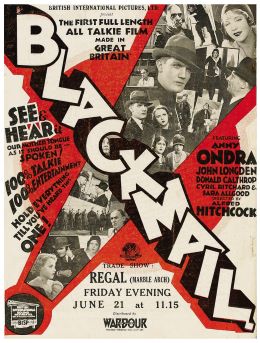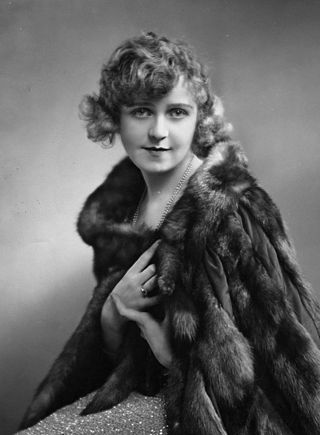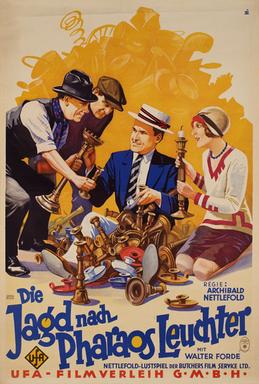Related Research Articles

A sound film is a motion picture with synchronized sound, or sound technologically coupled to image, as opposed to a silent film. The first known public exhibition of projected sound films took place in Paris in 1900, but decades passed before sound motion pictures became commercially practical. Reliable synchronization was difficult to achieve with the early sound-on-disc systems, and amplification and recording quality were also inadequate. Innovations in sound-on-film led to the first commercial screening of short motion pictures using the technology, which took place in 1923. Before sound-on-film technology became viable, soundtracks for films was commonly played live with organs or pianos.

Bessie Love was an American-British actress who achieved prominence playing innocent, young girls and wholesome leading ladies in silent and early sound films. Her acting career spanned nearly seven decades—from silent film to sound film, including theatre, radio, and television—and her performance in The Broadway Melody (1929) earned her a nomination for the Academy Award for Best Actress.

Blackmail is a 1929 British thriller directed by Alfred Hitchcock and starring Anny Ondra, John Longden, and Cyril Ritchard. Based on the 1928 play of the same name by Charles Bennett, the film is about a London woman who is blackmailed after killing a man who tries to rape her.
Sidney Gilliat was an English film director, producer and writer.

Henry William George Lupino professionally Lupino Lane, was an English actor and theatre manager, and a member of the famous Lupino family, which eventually included his cousin, the screenwriter/director/actress Ida Lupino. Lane started out as a child performer, known as 'Little Nipper', and went on to appear in a wide range of theatrical, music hall and film performances. Increasingly celebrated for his silent comedy short subjects, he is best known in the United Kingdom for playing Bill Snibson in the play and film Me and My Girl, which popularized the song and dance routine "The Lambeth Walk".
Phonofilm is an optical sound-on-film system developed by inventors Lee de Forest and Theodore Case in the early 1920s.

Betty Balfour was an English screen actress, popular during the silent era, and known as the "British Mary Pickford" and "Britain's Queen of Happiness". She was best known to audiences for her Squibs series of films.

John Stuart was born to Scottish parents, and was a very popular leading man in British silent films in the 1920s. He successfully made the transition to talking pictures in the 1930s and his film career went on to span almost six decades. He appeared in 172 films, 123 stage plays, and 103 television plays and series.
Frank Stanmore was an English film actor. He appeared in 76 films between 1914 and 1938. He was born in London and died in Gravesend, Kent.
Walter Forde was a British actor, screenwriter and director. Born in Lambeth, South London in 1898, he directed over fifty films between 1919 from the silent era through to 1949 in the sound era. He died in Los Angeles, California in 1984.
Wait and See is a 1928 British silent comedy film directed by Walter Forde and starring Frank Stanmore, Pauline Johnson and Sam Livesey.
Little Miss London is a 1929 British silent comedy film directed by Harry Hughes and starring Pamela Parr, Frank Stanmore and Reginald Fox. It was made by British Instructional Films at Bushey Studios. The screenplay concerns a business magnate who poses as a poor man while his daughter falls in love with a man posing as an aristocrat.
The Silent House is a 1929 British silent mystery film, directed by Walter Forde and starring Mabel Poulton, Gibb McLaughlin and Arthur Pusey. It was made in 1928 at the Nettlefold Studios in Walton-on-Thames and trade-shown in January 1929. The film was written by H Fowler Mear, based on a hit stage play by John G Brandon and George Pickett, but it was not a success at the box-office. A print of the film exists at the National Film Archive in London.

What Next? is a 1928 British silent comedy film directed by Walter Forde and starring Forde, Pauline Johnson and Frank Stanmore. It was made at Nettlefold Studios in Walton-on-Thames. There is a copy held at the BFI archive.
Would You Believe It! is a 1929 British silent comedy film directed by Walter Forde and starring Forde, Pauline Johnson and Arthur Stratton. It was made at the Nettlefold Studios in Walton-on-Thames and released as a supporting feature. Due to the general public's apathy toward silent films, it was quickly released in a sound version that features a synchronized musical score with sound effects.
Red Pearls is a 1930 British silent crime film directed by Walter Forde and starring Lillian Rich, Frank Perfitt and Arthur Pusey. It was made at the Nettlefold Studios in Walton. It was based on the novel Nearer! Nearer! by J. Randolph James. The film was produced just as the change to sound films was taking place in Britain.
Mother Love is a 1916 British silent drama film directed by Maurice Elvey starring Elisabeth Risdon, Fred Groves, and Frank Stanmore.

That's a Good Girl is a 1933 British comedy film directed by Jack Buchanan and starring Buchanan, Elsie Randolph and Dorothy Hyson. The film was based on a musical show of the same title that opened at the Lewisham Hippodrome on 19 March 1928, in which Jack Buchanan also starred. The music was written by Joseph Meyer and Phil Charig, with lyrics by Douglas Furber. The film omitted much of music of the original show, but popularised one song in particular, Fancy our Meeting. The song remained a Jack Buchanan favourite and a version of it was also recorded by Al Bowlly shortly after the film's release.
Chamber of Horrors is a 1929 British silent horror film directed by Walter Summers and starring Frank Stanmore and Elizabeth Hempel. It was made at Welwyn Studios. Film historians consider this movie the last major silent film made in England.
Squibs' Honeymoon is a 1923 British silent comedy film directed by George Pearson and starring Betty Balfour, Hugh E. Wright and Fred Groves. It was the last of the silent film series featuring the character, although Balfour returned to play her in the 1935 sound film Squibs. Both Pearson and Balfour were particular favourites of the British film critic, and later leading screenwriter, Roger Burford. In his first article for the magazine Close Up Burford would write "Not long ago a film of the Squibbs series was reported to be on at a small cinema in a slum district. It was a rare chance, and we went at once. We were not disappointed: the film was English, with proper tang; the tang of Fielding or Sterne.' Burford's comments help place the Squibbs films perfectly in British culture between the wars. They were very much working-class comedy, drawing on a vernacular, performative tradition, but at the same time their "Englishness" is characteristic of the kinds of satirical comedies found in the novels of Henry Fielding and Laurence Sterne. That earthy satire, based on everyday life, made these comedies unpalatable to middle class audiences but the Squibbs films were amongst the most interesting, and well shot, films in Britain in the 1920s.
References
- ↑ "You'd Be Surprised". British Film Institute. Archived from the original on 10 March 2016. Retrieved 10 September 2018.
- ↑ "Kennington Bioscope presents Silent Laughter Saturday » The Cinema Museum, London". The Cinema Museum, London. Retrieved 10 September 2018.
- ↑ Low p.413
- ↑ Hal Erickson. "You'd Be Surprised (1930) - Walter Forde - Synopsis, Characteristics, Moods, Themes and Related". AllMovie. Retrieved 10 September 2018.